
Ang Mo Kio is a planning area and residential town situated in the North-East of Singapore. Located approximately 11 kilometres (6.8 mi) north of the Downtown Core district, Ang Mo Kio is the 3rd most populated planning area in the North-East Region and ranks 8th in terms of population in the country overall. The planning area is located at the south-western corner of the North-East Region, bordered by the planning areas of Yishun to the north, Sengkang to the north-east, Serangoon to the east, Bishan to the south and the Central Water Catchment to the west.

The Singapore River is a river that flows parallel to Alexandra Road and feeds into the Marina Reservoir in the southern part of Singapore. The immediate upper watershed of the Singapore River is known as the Singapore River Planning Area, although the western part of the watershed is classified under the River Valley planning area.

Marina Bay is a bay located in the Central Area of Singapore, surrounded by the perimeter of four other planning areas, the Downtown Core, Marina East, Marina South and Straits View. The area surrounding the bay itself, also called Marina Bay, is a 360 hectare extension to the adjacent Central Business District. It is also the new downtown of Singapore, built on reclaimed land.

The Central Area, also called the City Area, and informally The City, is the city centre of Singapore. Located in the south-eastern part of the Central Region, the Central Area consists of eleven constituent planning areas: the Downtown Core, Marina East, Marina South, the Museum Planning Area, Newton, Orchard, Outram, River Valley, Rochor, the Singapore River and Straits View, as defined by the Urban Redevelopment Authority. The term Central Business District (CBD) has also been used to describe most of the Central Area as well, although its boundaries lie within the Downtown Core.

The Science Centre Singapore, previously known as Singapore Science Centre is a scientific institution in Jurong East, Singapore, specialising in the promotion of scientific and technological education for the general public. It houses over 850 exhibits over eight exhibition galleries and receives over a million visitors every year. In 2003, it celebrated its silver jubilee.

The Johor–Singapore Causeway is a 1.056-kilometre (0.66 mi) causeway consisting of a combined railway and motorway bridge that links the city of Johor Bahru in Malaysia across the Straits of Johor to the district and town of Woodlands in Singapore. Historically, it was the only land connection between the two countries until the opening of the Tuas Second Link in 1998.
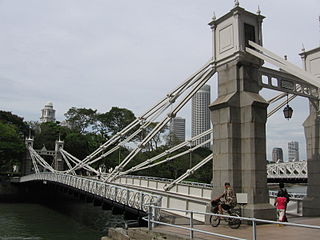
Cavenagh Bridge is the only suspension bridge and one of the oldest bridges in Singapore, spanning the lower reaches of the Singapore River in the Downtown Core. Opened in 1869 to commemorate Singapore's new Crown colony of the Straits Settlements status in 1867, it is the oldest bridge in Singapore that exists in its original form.

Elgin Bridge is a vehicular box girder bridge across the Singapore River, linking the Downtown Core to the Singapore River Planning Area located within Singapore's Central Area. It was built between 1925 and 1929.

Anderson Bridge is a pedestrian bridge that spans across the Singapore River. It is located near the river's mouth in the Downtown Core Planning Area of Singapore's Central Area.
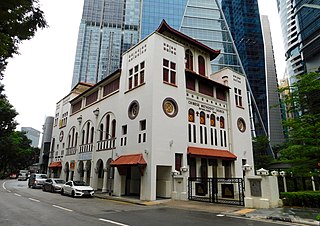
Telok Ayer Chinese Methodist Church, is located on Telok Ayer Street within the Downtown Core of Singapore's central business district. The church is approximately 450 metres from Telok Ayer MRT station.
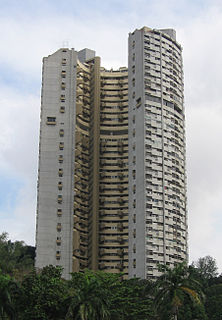
Pearl Bank Apartments was a high-rise private residential building on Pearl's Hill in Outram, near the Chinatown area of Singapore.

Golden Mile Complex is a high-rise commercial and residential building on Beach Road in Kallang, Singapore, within walking distance to Nicoll Highway MRT station. The building was formerly known as Woh Hup Complex. The complex contains 411 shops and 500 parking spaces. The building is largely an ethnic enclave for the Thai population in Singapore.

Stamford House is a historic building located at the corner of the junction of Stamford Road and Hill Street, in the Downtown Core of Singapore. Originally known as Oranje Building, it formerly housed a shopping mall. The building had since redeveloped along with adjoined Capitol Building and both were reopened as a hotel The Capitol Kempinski Hotel Singapore in October 2018.

Yue Hwa Building is a historic building located at the junction of Eu Tong Sen Street and Upper Cross Street in Chinatown, Singapore, next to Chinatown MRT station. Built by Swan and Maclaren in 1927, it was then the tallest building in Chinatown and was known as Nam Tin Building (南天大厦), owned by Lum Chang Holdings. The building housed the six-storey Great Southern Hotel, along with a few shops and cabarets that were popular among Chinese travellers. In 1993, Lum Chang Holdings sold the building to Hong Kong businessman Yu Kwok Chun, who converted it to the first Yue Hwa Chinese Products department store in Singapore in 1994. The renovation process, which conserved the exterior while adding features such as an atrium and waterfall to the interior, won the building the Architectural Heritage Award by the Urban Redevelopment Authority in 1997.
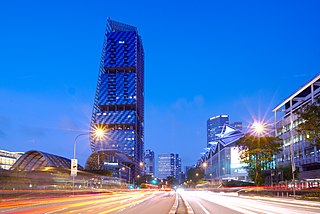
South Beach is a commercial and residential complex located on Beach Road in the Downtown Core of Singapore. It is composed of a hotel tower managed by JW Marriott Hotels, an office tower, shops and residences. The project includes the restoration of four conservation buildings – the former Non-Commissioned Officers' Club building and part of the former Beach Road Camp. It is accessible from Esplanade MRT station.

The Southern Ridges comprise 10 kilometres (6.2 mi) of trails connecting three parks along the southern ridge of Singapore. Some of the attractions along these trails include its greenery and the connecting bridges. This project linked up the parks between the Kent Ridge Park and HarbourFront. The idea to link these parks was coined in 2002 by Urban Redevelopment Authority (URA) and it took 2 years to complete and cost S$25.5 million.

Baba House is a museum in Singapore, showcasing Peranakan history, architecture and heritage. It is a traditional Peranakan pre-war terrace-house which was formerly owned by the family of a 19th-century shipping tycoon Wee Bin who settled in Singapore, after arriving from the southern Chinese province of Fujian. The Baba House is also an outpost of the National University of Singapore (NUS) Museum and co-managed by the NUS Centre for the Arts.

West 8 is an urban planning and landscape architecture firm founded by Adriaan Geuze and Paul van Beek in Rotterdam, Netherlands in 1987. It is known for its contemporary designs and innovative solutions to urban planning problems using lighting, metal structures, and color. Van Beek is no longer part of the firm.
Singapore City Gallery, formerly known as URA Gallery, is a three-storey visitor centre located in The URA Centre, Singapore that charts Singapore's urban transformation and future plans. It was established in January 1999 and is managed by the Urban Redevelopment Authority (URA). It features a large model replica of the Central Area of Singapore.
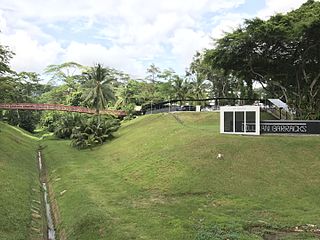
Gillman Barracks is a contemporary arts cluster in Singapore that is home to international art galleries, restaurants and the NTU Centre for Contemporary Art Singapore, which are all housed in conserved colonial barracks. Gillman Barracks lies near to Alexandra Road, and the 6.4 hectare site covers Lock Road and Malan Road amid greenery. Gillman Barracks is jointly developed by the Singapore Economic Development Board, JTC Corporation and the National Arts Council.





















